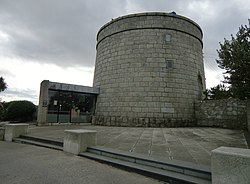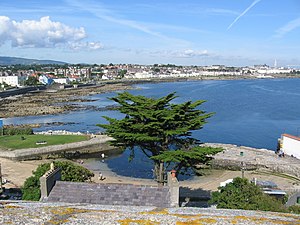James Joyce Tower
| James Joyce Tower | |
|
County Dublin | |
|---|---|
 The James Joyce Tower | |
| Type: | Martello tower |
| Location | |
| Grid reference: | O25842811 |
| Location: | 53°17’19"N, 6°6’49"W |
| Village: | Sandycove |
| History | |
| Information | |
| Website: | joycetower.ie |
The James Joyce Tower and Museum is a Martello tower in the coast of Dublin Bay in Sandycove, County Dublin. It was built in 1804, during the Napoleonic War: it was one of a series of such towers built to defend the approaches to Dublin against potential French invasion. The tower was never called into action.
After Napoleon's defeat, the tower, along with the others in the system, were used as a coast guard station and stayed in general use by the army.
In the early years of the twentieth century the War Office leased the tower to Oliver St John Gogarty, who determined on the romantic idea of "Hellenising" Ireland. In 1904 during his tenancy, Gogarty was visited by his university friend, the author James Joyce, spent six nights here in 1904,[1] an stay which inspired his most famous novel. The tower's modern name is a tribute to Joyce.
The opening scenes of Joyce's 1922 novel Ulysses take place here, the whole narrative of the novel taking place on 16 June 1904. For this reason, the tower has become a place of pilgrimage for Joyce enthusiasts, especially on Bloomsday (16 June). Admission is free.[2]
Joycean history


The tower was leased from the War Office by Joyce's university friend Oliver St. John Gogarty, with the purpose of "Hellenising" Ireland. Joyce stayed there for six days, from 9 to 14 September in 1904. Gogarty later attributed Joyce's abrupt departure to a midnight incident with a loaded revolver.[3]
The opening scenes of Ulysses are set the morning after this incident. Gogarty is immortalised as "Stately, plump Buck Mulligan" (the opening words of the novel).
The tower now contains a museum dedicated to Joyce and displays some of his possessions and other ephemera associated with Ulysses (for example, an empty pot of "Plumtree's Potted Meat"). The living space is set up to resemble its 1904 appearance, and contains a ceramic panther to represent one seen in a dream by a resident. It is a place of pilgrimage for Joyce enthusiasts, especially on Bloomsday.
The Tower became a museum opening on 16 June 1962 through the efforts of Dublin artist John Ryan. Ryan also rescued the front door to 7 Eccles Street (now at the James Joyce Centre) from demolition and organised, with Brian O'Nolan, the first Bloomsday Celebration in 1954.
The museum is run by the Friends of Joyce Tower Society on a voluntary basis.
Outside links
References
- ↑ Bowker, Gordon (2012). James Joyce: A New Biography. New York: Farrar, Straus, Giroux. pp. 130–131.
- ↑ "James Joyce Tower and Museum". http://jamesjoycetower.com/.
- ↑ Gogarty, Oliver (1948). Mourning Became Mrs. Spendlove. New York: Creative Age Press. pp. 56–57.
- Ryan, Susan (20 August 2012). "Joyce Tower set to reopen thanks to volunteer support". TheJournal.ie. http://www.thejournal.ie/joyce-tower-set-to-reopen-thanks-to-volunteer-support-565011-Aug2012/.